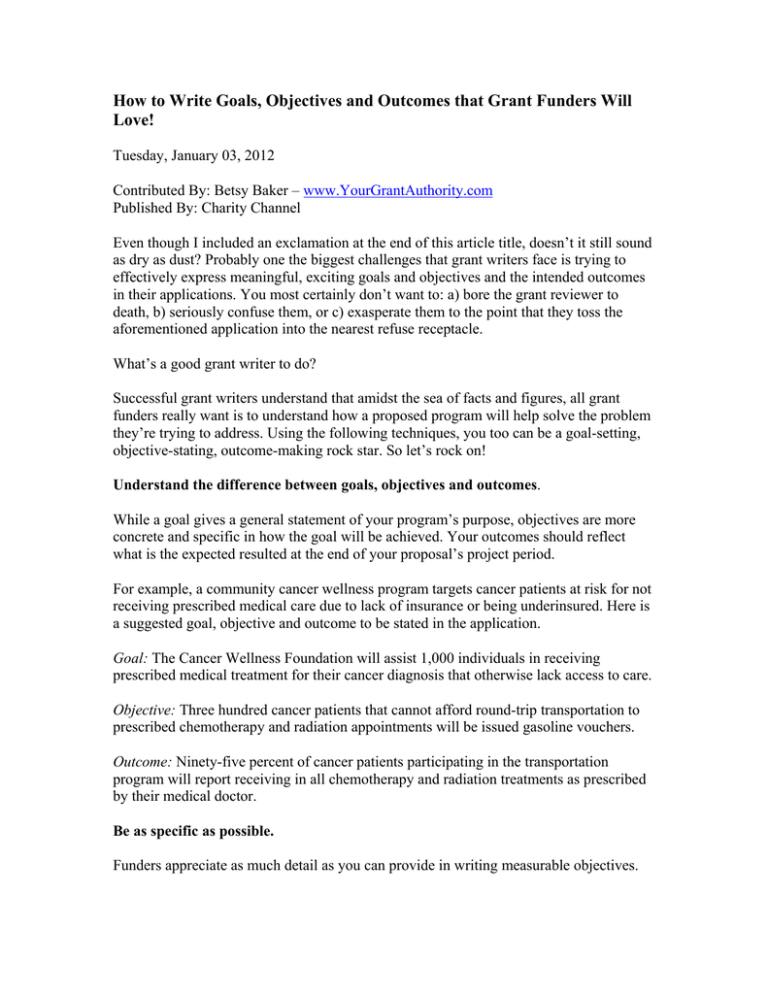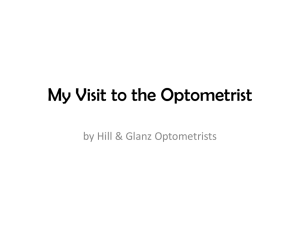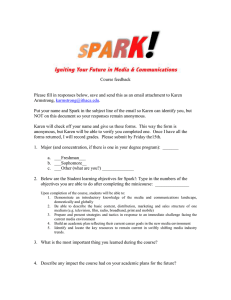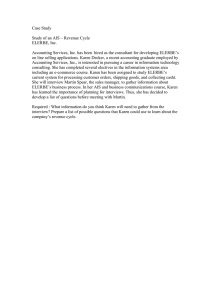Grant Writing: Goals, Objectives, and Outcomes
advertisement

How to Write Goals, Objectives and Outcomes that Grant Funders Will Love! Tuesday, January 03, 2012 Contributed By: Betsy Baker – www.YourGrantAuthority.com Published By: Charity Channel Even though I included an exclamation at the end of this article title, doesn’t it still sound as dry as dust? Probably one the biggest challenges that grant writers face is trying to effectively express meaningful, exciting goals and objectives and the intended outcomes in their applications. You most certainly don’t want to: a) bore the grant reviewer to death, b) seriously confuse them, or c) exasperate them to the point that they toss the aforementioned application into the nearest refuse receptacle. What’s a good grant writer to do? Successful grant writers understand that amidst the sea of facts and figures, all grant funders really want is to understand how a proposed program will help solve the problem they’re trying to address. Using the following techniques, you too can be a goal-setting, objective-stating, outcome-making rock star. So let’s rock on! Understand the difference between goals, objectives and outcomes. While a goal gives a general statement of your program’s purpose, objectives are more concrete and specific in how the goal will be achieved. Your outcomes should reflect what is the expected resulted at the end of your proposal’s project period. For example, a community cancer wellness program targets cancer patients at risk for not receiving prescribed medical care due to lack of insurance or being underinsured. Here is a suggested goal, objective and outcome to be stated in the application. Goal: The Cancer Wellness Foundation will assist 1,000 individuals in receiving prescribed medical treatment for their cancer diagnosis that otherwise lack access to care. Objective: Three hundred cancer patients that cannot afford round-trip transportation to prescribed chemotherapy and radiation appointments will be issued gasoline vouchers. Outcome: Ninety-five percent of cancer patients participating in the transportation program will report receiving in all chemotherapy and radiation treatments as prescribed by their medical doctor. Be as specific as possible. Funders appreciate as much detail as you can provide in writing measurable objectives. For example, an after school program targets at-risk teenage youth in assisting them to complete their high school education. One objective: Eighty-five percent of program participants will have a better understanding of math and reading skills enabling them to complete graduation requirements in the future. A better objective: Eighty-five percent of program participants will score at least one grade level higher by the end of their first year of participation in the program. Put a face on your facts and figures. While statistics are an important element in conveying your need and urgency, try to include specific examples of clients you help that can paint a visual picture in the grant reviewer’s mind. While the above example provides meaningful data, look how the following example brings the program to life: When Karen came to the XYZ Youth Center, she was struggling and scared that she would not be able to complete her education. She had been skipping classes at least twice a week and tested two grades behind her classmates. Because Karen’s parents both worked long hours to help support the family, she did not get the extra help and encouragement she needed at home. Referred by a social worker, Karen became a participant in the XYZ Program and began working with a mentor who provided one-onone support for her. She also attended weekly support meetings with other kids who, like Karen, were struggling. Six months later, Karen reported feeling less frustrated when she studied and even began finding her math and reading classes exciting. By the end of Karen’s first year in the program, she tested at grade level and was excited to move forward into the next grade with her class. Remember, it might not be the most enjoyable part of writing your grant application, but the goals and objectives section is an important one. The time it takes you to create meaningful program measurements is always time well spent.



